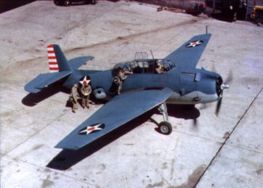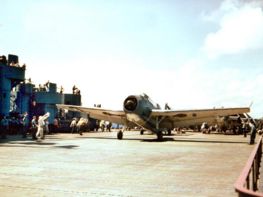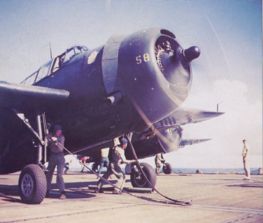PlaneSpottingWorld welcomes all new members! Please gives your ideas at the Terminal.
TBF Avenger
| TBF Avenger TBM Avenger | |
|---|---|
| Type | Torpedo bomber |
| Manufacturer | Grumman General Motors |
| Designed by | Leroy Grumman |
| Maiden flight | 7 August, 1941 |
| Introduced | 1942 |
| Retired | 1960s |
| Status | Retired |
| Primary users | United States Navy Fleet Air Arm Royal Canadian Navy Royal New Zealand Air Force |
| Number built | 9,837 |
The Grumman TBF Avenger (designated TBM for aircraft manufactured by General Motors) was an American torpedo bomber, developed initially for the United States Navy and Marine Corps and used by a large number of air forces around the world. It entered service in 1942, and first saw action during the Battle of Midway.
The Douglas Devastator, the main torpedo bomber of the U.S. Navy (from 1935 to about 1942) had become obsolete by 1939. In order to replace it, Grumman (the "Iron Works") was contracted to create a new replacement. Designed by Leroy Grumman, its first prototype was called the XTBF-1. Although one of the first two prototypes crashed near Brentwood, New York, rapid production continued.
Contents
Design

Grumman's first torpedo bomber was the heaviest single-engine plane of WWII, and it was the first to feature a new wing-folding mechanism (designed by Grumman) intended to maximize storage space on an aircraft carrier; the F6F Hellcat (also manufactured by Grumman) would employ the same mechanism. The engine used was the Wright R-2600-20 (which produced 1,900 horsepower). There were three crew members—pilot, turret gunner, and radioman/bombardier/ventral gunner. A .50-caliber machine gun was mounted in each wing, and one more .50 caliber gun was mounted right next to the turret gunner's head in a rear-facing electrically powered turret. There was a single .30 caliber hand-fired machine gun mounted ventrally (under the tail), which was used to defend against enemy fighters attacking from a below and to the rear. This gun was fired by the radioman/bombardier while standing up and bending over in the belly of the tail section, though he usually sat on a folding bench facing forward to operate the radio and to sight in bombing runs. There was only one set of controls on the aircraft, and no access to the pilot's position from the rest of the aircraft. The radio equipment was massive, especially by today's standards, and filled the whole glass canopy to the rear of the pilot. The radios were accessible for repair through a "tunnel" along the right hand side. Any Avengers that are still flying today usually have an additional rear-mounted seat in place of the radios, which increases crew to four.
During the Battle of Midway, all of the three aircraft carriers' torpedo groups (from the USS Hornet, USS Enterprise, and USS Yorktown) had taken horrendous casualties; one group had a single survivor (Ensign George Gay). This was partly due to the slow speed of the Devastator (less than 200 mph (320 km/h) during glide-bombing) and its weak defensive armament. Ironically, the first shipment of TBFs had arrived only a few hours after the three carriers quickly departed from Pearl Harbor (although a few eventually participated launched from Midway Island).
The Avenger had a large bomb bay, allowing for one Bliss-Leavitt Mark 13 torpedo, a single 2000 lb (900 kg) bomb, or up to four 500 lb (230 kg) bombs. Torpedoes were generally abandoned after Midway and were not carried again regularly until after June of 1944, when improvements mandated their use again. By that time, it was rare for American aircraft to encounter enemy shipping at sea and the Avenger was primarily employed as a ground support weapon. The plane had overall ruggedness and stability, and pilots say it flew like a truck, for better or worse. With its good radio facilities, docile handling, and long range, the Grumman Avenger also made an ideal command aircraft for Air Group Commanders (CAGs). With a 30,000 foot (10,000 m) ceiling and a fully-loaded range of 1,000 miles (1,600 km), it was better than any previous American torpedo plane, and better than its chief opponent, the then obsolete Japanese Nakajima B5N "Kate". Later Avenger models carried radar equipment for the ASW and AEW roles. Although improvements in new types of aviation radar were soon forthcoming from the engineers at MIT and the electronic industry, the available radars in 1943 were very bulky, because they contained vacuum tube technology. Because of this, radar was at first carried only on the roomy TBF Avengers, but not on the smaller and faster fighters.
General history

On the afternoon of December 7, 1941, Grumman held a ceremony to open a new manufacturing plant and display the new TBF to the public. Ironically, on that day, the Imperial Japanese Navy attacked Pearl Harbor, as Grumman soon found out. After the ceremony was over, the plant was quickly sealed off to ward against possible enemy action. By early June 1942, though, a shipment of more than 100 planes was sent to the Navy (although, as mentioned before, most were too late to participate in the fateful Battle of Midway).
However, six TBF-1s were present on Midway Island, as part of VT-8 (Torpedo Squadron 8), while the rest of the squadron flew Devastators from the Hornet. Unfortunately, most of the pilots had very little previous experience, and only one TBF survived (with heavy damage and casualties). As author Gordon Prange mentions in Miracle at Midway, the outdated Devastators (and lack of new planes) contributed somewhat to the lack of a complete victory (and the loss of the Yorktown); bravery was no equal to superior planes.
On August 24, 1942, the next major naval battle occurred at the Eastern Solomons. With only two carriers (the USS Saratoga and the Enterprise), the 24 TBFs present were able to sink the Japanese aircraft carrier Ryūjō and claim one dive bomber, at the cost of seven planes. During the early war period, a non-aircraft related problem had emerged: the faulty torpedoes used by the U.S. Navy had failed to explode (even on direct hits) on many occasions; Prange mentions a likely problem in the magnetic detonation device (at Midway, one submarine (USS Nautilus (SS-168)) actually hit the Sōryū with a faulty torpedo, although after it was already incapacitated).
The first major "prize" for the TBFs (which had been assigned the name "Avenger" in October 1941, before the Japanese attack on Pearl Harbor) was at the Naval Battle of Guadalcanal in November 1942, when Marine Corps and Navy Avengers helped sink the battleship Hiei.
After hundreds of the original TBFs were built (designated the TBF-1), the TBF-1C began production. The allotment of space for specialized internal and wing-mounted fuel tanks doubled the Avenger's range. By 1943, Grumman began to slowly phase out production of the Avenger to produce F6F Hellcat fighters, and the Eastern Aircraft Division of General Motors took over (causing the designation to be changed to the TBM). Starting in mid-1944, the TBM-3 began production (with a more powerful powerplant and wing hardpoints for drop tanks and rockets). The dash-3 was the most numerous of the Avengers (with about 4,600 produced). However, most of the Avengers were dash-1s until near the end of the war (in 1945).
Besides the traditional surface role (torpedoing surface ships), Avengers claimed about thirty submarine kills, including the cargo submarine I-52, whose remains were found in 1998. They were one of the most effective sub-killers in the Pacific theatre, as well as in the Atlantic, when escort carriers were finally available to escort Allied convoys. There, the Avengers contributed in warding off German U-Boats while providing air cover for the convoys.
After the "Marianas' Turkey Shoot", in which more than 250 Japanese aircraft were downed, Admiral Marc Mitscher ordered a 220-aircraft mission to find the Japanese task force. At the extreme end of their range (300 nautical miles out), the group of Hellcats, TBF/TBMs, and dive bombers took many casualties. However, Avengers from USS Belleau Wood (CVL-24) torpedoed the light carrier Hiyō as their only major prize. Mitscher's gamble did not pay off as well as he had hoped.
In June 1943, future-President George H.W. Bush became the youngest naval aviator at the time. While flying a TBM with VT-51 (from the USS San Jacinto), his plane was shot down on September 2, 1944 over the Pacific island of Chichi Jima. Both of his crewmates died; however, because he released his payload and hit the target before being forced to bail out, he received the Distinguished Flying Cross.
Near the end of the war, TBF/TBMs sank two of the Japanese "super battleships": the Musashi and the Yamato (which was Admiral Isoroku Yamamoto's flagship for most of the war). The Avengers played a very major role in the American victory during World War II, although torpedoes had become largely outdated (replaced by the faster and more effective dive bombers) by then.
The Avenger was also used by the Royal Navy's Fleet Air Arm where it was initially known as the "Tarpon" however this name was later discontinued and the Avenger name used instead. The first 402 aircraft were known as Avenger Mk 1, 334 TBM-1s from Grumman were the Avenger Mk II and 334 TBM-3 the Mark III. Post war the antisubmarine version was the "Avenger AS Mk IV" in RN service.
The only other operator in World War II was the Royal New Zealand Air Force which used the type primarily as a bomber, operating from South Pacific Island bases. Some of these were transferred to the British Pacific Fleet.
In 1945 Avengers were involved in pioneering trials of aerial topdressing in New Zealand that led to the establishment of an industry which markedly increased food production and efficiency in farming worldwide. Pilots of the Royal New Zealand Air Force's 42 Squadron spread fertilizer from Avengers beside runways at Ohakea air base.
The post-war disappearance of a flight of American Avengers, known as Flight 19, began the Bermuda Triangle legend.
Many Avengers survived the remainder of the 20th century as firebombers in New Brunswick.
There are also Avengers in Private collections around the world [1]
Famous incidents
Flight 19
Flight 19 disappeared on December 5, 1945 while on a training mission over the Atlantic. According to the popular Triangle stories, the flight leader reported a number of odd visual effects while lost; i.e. mentions of "white water", the ocean "not looking as it should", and his compass spinning out of control, before simply disappearing. Furthermore, Berlitz in his book claimed that because the TBM Avenger bombers were built to float for long periods, they should have been found the next day considering what were reported as calm seas and a clear sky. However, not only were the planes never found, a Navy search and rescue seaplane that went after them was also lost and never found. Adding to the intrigue is that the Navy's report of the accident was ascribed to "causes or reasons unknown".[1]
While the basic facts of the Triangle version of the story are essentially accurate, some important details are missing. The popular image of a squadron of seasoned combat aviators disappearing on a sunny afternoon did not happen. By the time the last radio transmission was received from Flight 19, stormy weather had moved in. Only the Flight Leader, Lt. Charles Carroll Taylor, had combat experience and any significant flying time, but at the same time he had less than six months of flight experience in the south Florida area, less than the trainees serving under him, and a history of getting lost in flight, having done so three times previously in the Pacific theater during World War II and being forced to ditch his planes twice into the water. Lt. Taylor also has since been depicted as a cool, calm and confident leader. Instead, radio transmissions from Flight 19 revealed Taylor to be disoriented, lacking confidence in his decisions, and completely lost.
Exaggerated claims also often stated that all the planes were having compass problems, however later naval reports and written recordings of the conversations between Lt. Taylor and the other pilots of Flight 19 do not indicate this. As for the Navy's report, it is stated that blame for the loss of the aircraft and men rest upon the flight leader's confusion. However the wording was changed from blaming Taylor to "cause unknown" in a second official report in deference to the wishes of his family. It was this incident as stated in the second, altered report, plus the later losses of the airliners Star Tiger and Star Ariel, which began the legend of the Bermuda Triangle. [1]
Specifications (TBF Avenger)
General characteristics
- Crew: 3
- Length: 40 ft 11.5 in (12.48 m)
- Wingspan: 54 ft 2 in (16.51 m)
- Height: 15 ft 5 in (4.70 m)
- Wing area: 490.02 ft² (45.52 m²)
- Empty weight: 10,545 lb (4,783 kg)
- Loaded weight: 17,893 lb (8,115 kg)
- Powerplant: 1× Wright R-2600-20 radial engine, 1,900 hp (1,420 kW)
Performance
- Maximum speed: 276 mph (444 km/h)
- Range: 1,000 miles (1,610 km)
- Service ceiling: 30,100 ft (9,170 m)
- Rate of climb: 2,060 ft/min (10.5 m/s)
- Wing loading: 36.5 ft·lbf² (178 kg/m²)
- Power/mass: 0.0094 hp/lb (0.17 kW/kg)
Armament
- 1x 0.30 cal (7.62 mm) nose-mounted machine gun
- 2x 0.50 cal (12.7 mm) wing-mounted machine guns
- 1x 0.50 cal (12.7 mm) dorsal-mounted machine gun
- 1x 0.30 cal (7.62 mm) ventral-mounted machine gun
- Up to 2,000 lb (900 kg) of bombs
- 1x 2,000 lb (900 kg) torpedo
Operators
- Brazil (postwar)
- Canada (postwar)
- Royal Canadian Navy (Until 1960's, replaced by the Grumman Tracker)
- Japan (postwar)
- Netherlands (postwar)
- New Zealand
- Royal New Zealand Air Force
- No. 30 Squadron RNZAF
- No. 31 Squadron RNZAF
- No. 41 Squadron RNZAF
- No. 42 Squadron RNZAF
- Central Fighter Establishment
- Royal New Zealand Air Force
- United Kingdom
- United States
- Uruguay (postwar).
References
- Prange, Gordon William, et. al. (1983). Miracle at Midway. Viking. ISBN 0-14-006814-7.
- Drendal, Lou (2001). Walk Around, TBF/TBM Avenger. Squadron/Signal Publications. ISBN 0-89747-424-4.
External links
Related content
Comparable aircraft
- Fairey Barracuda
- Fairey Firefly
- Nakajima B5N
- Nakajima B6N
- TBD Devastator
- TB2D Skypirate
- TBY Sea Wolf
Designation sequence
Related lists
Lists relating to aviation | |
|---|---|
| General | Timeline of aviation · Aircraft · Aircraft manufacturers · Aircraft engines · Aircraft engine manufacturers · Airports · Airlines |
| Military | Air forces · Aircraft weapons · Missiles · Unmanned aerial vehicles (UAVs) · Experimental aircraft |
| Notable incidents and accidents | Military aviation · Airliners · General aviation · Famous aviation-related deaths |
| Records | Flight airspeed record · Flight distance record · Flight altitude record · Flight endurance record · Most produced aircraft |
de:Grumman TBF es:TBF Avenger fr:TBF Avenger it:Grumman TBF Avenger nl:TBF Avenger ja:TBF (航空機) pl:Grumman TBF Avenger ru:Эвенджер sl:Grumman TBF Avenger




